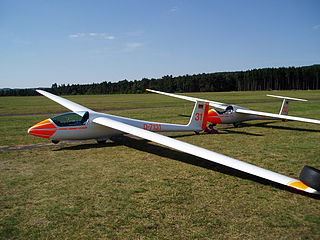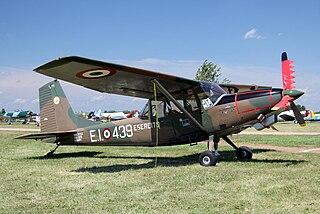| ATS-1 Ardhra | |
|---|---|
| Role | Training sailplane |
| Manufacturer | Civil Aviation Department of India, Hindustan Aeronautics |
| First flight | 5 March 1979 |
The Hindustan Ardhra ("Green" or "The Moist One" in Sanskrit) [1] was a sailplane designed in India for pilot training by the government's Civil Aviation Department in the late 1970s as the ATS-1 Ardhra. It was a two-seat aircraft of conventional configuration and wooden construction. The Indian Air Force ordered fifty examples in the early 1980s to be produced by Hindustan Aeronautics and the type was approved for use for flying by cadets.
Data from Jane's All the World's Aircraft 1988-89 [2]
General characteristics
Performance

The ASW 19 is a single-seat glider built by Alexander Schleicher GmbH & Co, first flying in 1975. It was originally designed as a Standard Class glider, but now mainly competes in the Club Class. The ASW 19 is known for its pleasant handling and some clubs use it as a training glider. It was succeeded by the all-new Schleicher ASW 24.

The LET L-23 Super Blaník is a two-seat, all-metal structure glider with fabric covered control surfaces. The aircraft is primarily used for flight training; its single-seat sister model is the Let L-33 Solo.

The ICA IS-29 was a sailplane built in Romania in the 1970s. The prefix IS comes from Iosif Șilimon, the Romanian IAR aeronautical engineer who designed it.

The Found Centennial 100 is a Canadian six-seat cabin monoplane produced by Found Brothers Aviation.

The Schleicher ASK 23 is a single-seat Club Class sailplane that was built by the German manufacturer Alexander Schleicher GmbH & Co.

The Fournier RF 5 is a two-seat motor glider designed by René Fournier.

The SIAI-Marchetti SM.1019 is an Italian STOL liaison monoplane built by SIAI-Marchetti for the Italian Army. It is a turboprop-powered derivative of the Cessna O-1 Bird Dog.

The VSO 10 Vosa is a Standard and Club-Class glider designed and manufactured in the Czechoslovak Republic from December 1978 as a replacement for the VT-116 Orlik II.

The ICA IS-28 is a two-seat sailplane produced in Romania in the 1970s. An all-metal aircraft of conventional design with a T-tail, it was originally produced with 15-metre wings, but in 1973, production shifted to the IS-28B with 17-metre wings and numerous aerodynamic refinements. These included a smaller tail with decreased dihedral, decreased dihedral on the wings, and redesigned fuselage contours. This version first flew on 26 April 1973 and was subsequently produced in versions with flaps (IS-28B2) and without (IS-28B1). Around 100 had been built by the early 1980s, with a substantial number sold for export. On April 7, 1979, Tom Knauff and R. Tawse set a world record with the IS-28 B2 glider, covering a distance of 829 kilometres on a predetermined out-and-return course from the Ridge Soaring Gliderport in Julian, Pennsylvania.
The ICA IS-32 is an open class high-performance metal two-seat sailplane produced in Romania in the 1970s. A refinement of the IS-28B, it shared most of that aircraft's fuselage, mated to new wings and empennage. This new wing had a span of 20 metres, featuring interconnected ailerons and flaps, Schempp-Hirth-type airbrakes. It had no provision for water ballast. The monowheel undercarriage differed from the IS-28 in being fully retractable.
The Issoire Silène was a sailplane produced in France in the 1970s and early 1980s, intended primarily as a trainer. It was a conventional design of fibreglass construction in versions with fixed or retractable monowheel undercarriage. The aircraft featured side-by-side seating for two, with the seats slightly staggered in order to minimise fuselage width. French certification was obtained on 3 February 1978, and production began shortly thereafter at the rate of two aircraft per month.

The Valentin Taifun is a two-seat self-launching sailplane designed and built by Valentin Flugzeugbau GmbH of Hasfurt, Germany.

The Piel CP.80 Zephir , Piel CP.801 and Piel CP.802 are racing aircraft developed in France in the 1970s and marketed for homebuilding. They are compact, single-seat, single-engine monoplanes with low, cantilever wings.

The Scheibe SF 34 Delphin is a two-seat sailplane that was produced by Scheibe in Germany in the late 1970s and 1980s. Designed by Wolf Hoffmann and originally designated the SF H34, it was Scheibe's first unpowered aircraft of composite construction.
The Shenyang X-9 Jian Fan is a Chinese training glider built by the Shenyang Sailplane Factory at Shenyang.
The Chengdu X-7 Jian Fan is a Chinese basic trainer glider. First flying in 1966, at least 130 were built.

The Marske Monarch is a single-seat, high-wing, strut-braced, tailless ultralight glider and motor glider that was offered both as plans and a kit for amateur construction by Marske Aircraft.

The Politechnika Warszawska PW-2, also called the PW-2 Gapa, is a Polish lightweight high-wing, strut-braced single-seat, glider that was designed and built at the Warsaw University of Technology and also produced by DWLKK in the early 1990s. Total number of 19 gliders were built, including variant PW-2D bis.

The PZL Bielsko SZD-51 Junior is a Polish single-seat training and club sailplane.

The Radab Windex is a family of Swedish high-wing, single-seat aerobatic gliders and motor gliders that was designed by Sven Olof Ridder and produced initially by Radab and later by WindexAir AB as a kit for amateur construction.